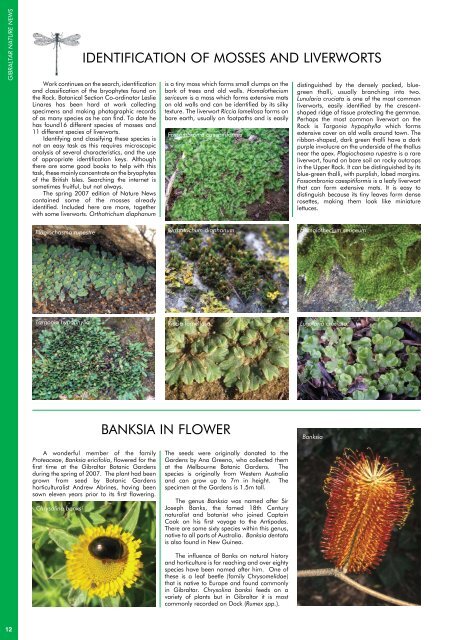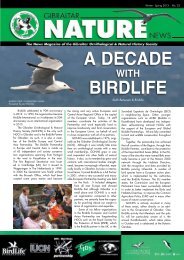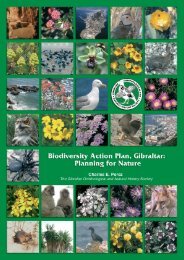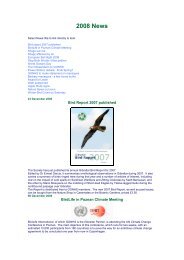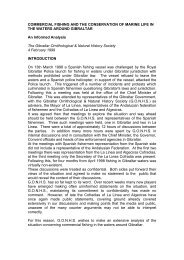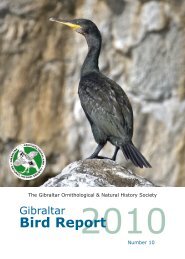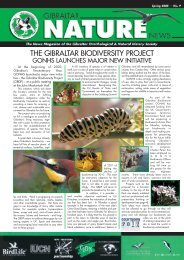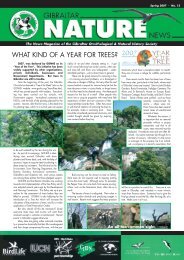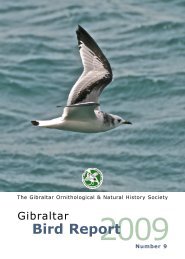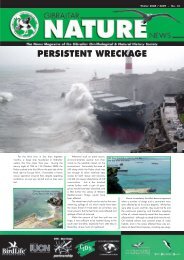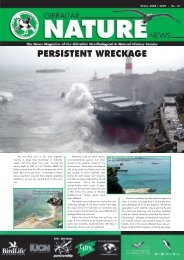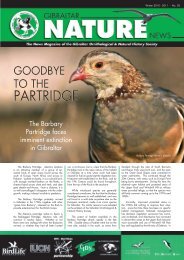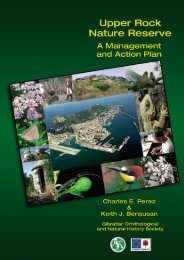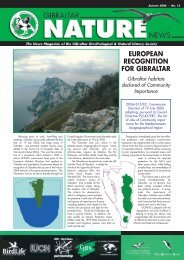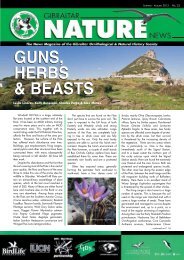No.15 - Gibraltar Ornithological & Natural History Society
No.15 - Gibraltar Ornithological & Natural History Society
No.15 - Gibraltar Ornithological & Natural History Society
You also want an ePaper? Increase the reach of your titles
YUMPU automatically turns print PDFs into web optimized ePapers that Google loves.
GIBRALTAR NATURE NEWS<br />
12<br />
Work continues on the search, identification<br />
and classification of the bryophytes found on<br />
the Rock. Botanical Section Co-ordinator Leslie<br />
Linares has been hard at work collecting<br />
specimens and making photographic records<br />
of as many species as he can find. To date he<br />
has found16 different species of mosses and<br />
11 different species of liverworts.<br />
Identifying and classifying these species is<br />
not an easy task as this requires microscopic<br />
analysis of several characteristics, and the use<br />
of appropriate identification keys. Although<br />
there are some good books to help with this<br />
task, these mainly concentrate on the bryophytes<br />
of the British Isles. Searching the internet is<br />
sometimes fruitful, but not always.<br />
The spring 2007 edition of Nature News<br />
contained some of the mosses already<br />
identified. Included here are more, together<br />
with some liverworts. Orthotrichum diaphanum<br />
Plagiochasma rupestre<br />
Targonia hypophylla<br />
A wonderful member of the family<br />
Proteaceae, Banksia ericifolia, flowered for the<br />
first time at the <strong>Gibraltar</strong> Botanic Gardens<br />
during the spring of 2007. The plant had been<br />
grown from seed by Botanic Gardens<br />
horticulturalist Andrew Abrines, having been<br />
sown eleven years prior to its first flowering.<br />
Chrysolina banksi<br />
IDENTIFICATION OF MOSSES AND LIVERWORTS<br />
is a tiny moss which forms small clumps on the<br />
bark of trees and old walls. Homalothecium<br />
sericeum is a moss which forms extensive mats<br />
on old walls and can be identified by its silky<br />
texture. The liverwort Riccia lamellosa forms on<br />
bare earth, usually on footpaths and is easily<br />
Fossombronia caespitiformis<br />
BANKSIA IN FLOWER Banksia<br />
The seeds were originally donated to the<br />
Gardens by Ana Greeno, who collected them<br />
at the Melbourne Botanic Gardens. The<br />
species is originally from Western Australia<br />
and can grow up to 7m in height. The<br />
specimen at the Gardens is 1.5m tall.<br />
The genus Banksia was named after Sir<br />
Joseph Banks, the famed 18th Century<br />
naturalist and botanist who joined Captain<br />
Cook on his first voyage to the Antipodes.<br />
There are some sixty species within this genus,<br />
native to all parts of Australia. Banksia dentata<br />
is also found in New Guinea.<br />
The influence of Banks on natural history<br />
and horticulture is far reaching and over eighty<br />
species have been named after him. One of<br />
these is a leaf beetle (family Chrysomelidae)<br />
that is native to Europe and found commonly<br />
in <strong>Gibraltar</strong>. Chrysolina banksi feeds on a<br />
variety of plants but in <strong>Gibraltar</strong> it is most<br />
commonly recorded on Dock (Rumex spp.).<br />
distinguished by the densely packed, bluegreen<br />
thalli, usually branching into two.<br />
Lunularia cruciata is one of the most common<br />
liverworts, easily identified by the crescentshaped<br />
ridge of tissue protecting the gemmae.<br />
Perhaps the most common liverwort on the<br />
Rock is Targonia hypophylla which forms<br />
extensive cover on old walls around town. The<br />
ribbon-shaped, dark green thalli have a dark<br />
purple involucre on the underside of the thallus<br />
near the apex. Plagiochasma rupestre is a rare<br />
liverwort, found on bare soil on rocky outcrops<br />
in the Upper Rock. It can be distinguished by its<br />
blue-green thalli, with purplish, lobed margins.<br />
Fossombronia caespitiformis is a leafy liverwort<br />
that can form extensive mats. It is easy to<br />
distinguish because its tiny leaves form dense<br />
rosettes, making them look like miniature<br />
lettuces.<br />
Orthotrichum diaphanum Homalothecium sericeum<br />
Riccia lamellosa Lunularia cruciata


